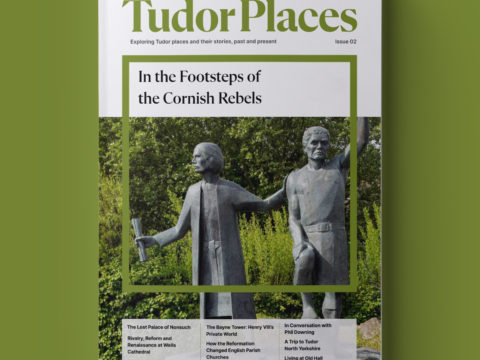Elizabeth of York: Life Story
Chapter 7 : Queen of England
Before anything could come of these discussions, it became apparent that Henry Tudor was planning an invasion. Again, there has been speculation about how much, or how little, Elizabeth might have supported his efforts. Much has been drawn from a sixteenth century ballad, called the Most Pleasant Song of the Lady Bessy.
In this work, attributed to Humphrey Brereton, the squire of Thomas, Lord Stanley, and thus well acquainted with Stanley’s wife, Lady Margaret Beaufort, Elizabeth takes an active part in promoting Henry’s invasion, even writing letters urging Yorkist adherents to support him.
Whatever Elizabeth’s private thoughts, either about her uncle or the unknown Henry Tudor, the uncertainty of the summer of 1485 must have been painful. She was sent to Sheriff Hutton, a castle in North Yorkshire, along with her cousin, the young Earl of Warwick, and perhaps Warwick’s sister, Margaret. There was another cousin, too, John de la Pole, Earl of Lincoln, who Richard may have nominated as his heir.
Throughout the summer, Richard awaited invasion. He established himself at Nottingham Castle, ready to move in any direction. Henry, together with his uncle, Jasper Tudor, landed at Milford Haven, in South Wales, on 7th August. He passed into England at Shrewsbury and carried on towards London, down the old Roman road. On 22nd August, Henry was victorious at the Battle of Bosworth. Richard was killed, and Henry was proclaimed King on the battlefield. Elizabeth’s fate was now in his hands.
One of Henry’s first acts was to send Sir Robert Willoughby for the little crowd of Yorkists at Sheriff Hutton. Elizabeth travelled to London, and was housed with Lady Margaret Beaufort, the latter now reunited with her son, and ready to fulfil the role of Queen Mother, even if she could not claim that as a title.
Whilst Henry had sworn to marry Elizabeth, and many of his supporters had taken the marriage with the heiress of York as a reason for following him, he was determined that his possession of the crown be seen as pertaining to him alone, not his as Elizabeth’s husband. He therefore arranged his own coronation at the end of October, and, at his first Parliament his title to the crown was declared. It was rather dubious – a combination of blood inheritance from Lancaster, and conquest, but not much worse than other titles had been. Strict heredity had not always been followed in England.
The same Parliament also overturned the Act of Titulus Regius, which had made Elizabeth illegitimate. It was considered so offensive that all copies were ordered to be destroyed, and it was over one hundred years before a stray copy came to light.
When no immediate arrangements were made for a marriage between Henry and Elizabeth, some Yorkists began to be nervous and Sir Thomas Lovell, Speaker of the House of Commons, presented a petition to the new King to urge the matter forward.
It has been suggested that Henry was biding his time deliberately because he wanted to establish himself firmly without relying on Elizabeth’s claim, or even that he intended to renege on his promise – although that would surely have been a far more risky act than Henry would have wished to take.
At any rate, he continued to maintain Elizabeth as a princess, paying for expensive clothes and even ermines – a marked sign of nobility. There was also the matter of the dispensation required, as Henry and Elizabeth were third and fourth cousins – they shared a common ancestor in John of Gaunt. Before Christmas, Henry confirmed his intention to marry Elizabeth to Parliament and preparations began.
On 16th January 1486, at St Paul’s, the Papal Legate, James, Bishop of Imola, heard a petition from Elizabeth and Henry, presented by their proctors – Dr William, Dean of the Arches and Dr Hill, Chaplain of the Royal Household for Elizabeth, and the Master of the Rolls and Dr Giglis for him. The depositions included sworn statements as to the blood relationship between the couple, made by Thomas Stanley, Earl of Derby, Henry’s step-father, and William Berkeley, Earl of Nottingham. Both gentlemen stated that they had known Elizabeth for fifteen or more years and that Henry’s mother, Lady Margaret Beaufort, and Elizabeth’s father, Edward IV, had held each other as ‘kinsmen’.
The dispensation was granted (along with a handy permission to eat dairy products and eggs during Lent) and the marriage solemnised on 18th January 1486, at Westminster, with Cardinal Thomas Bourchier, Archbishop of York, officiating.
Elizabeth was now Queen of England, and thus the union of Lancaster and York, to be symbolised by the red and white Tudor rose, was born.
Within six weeks, Elizabeth’s mother had been restored to many of her dower rights, although obliged to share some of her status with Margaret Beaufort. Elizabeth’s half-brother, Thomas, Marquess of Dorset, was also redeemed from his position as surety for a loan from the French crown and brought home, and her grandmother, Cicely, Duchess of York, received grants.
Elizabeth of York
Family Tree


